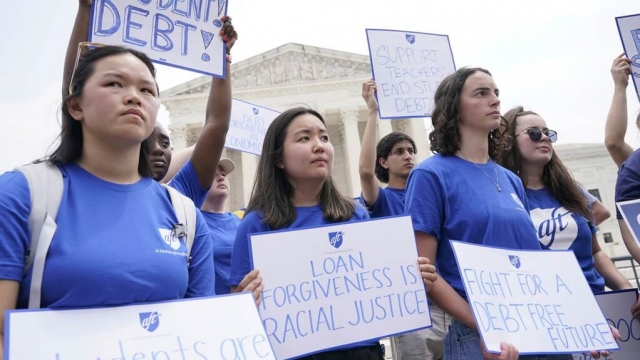Student loan repayments are resuming on October 1st, after a protracted legal battle led by the Biden administration. Interest on loans has already started accruing again.
The administration is still providing debt forgiveness to around 800,000 borrowers and installing a new income-driven repayment plan.
But that still leaves the rest of the 43.5 million Americans who will be paying an average of $337 a month to service their loans.
Some economists have warned that this could slow down consumer spending, which has been surprisingly steady amid inflation. It also coincides with other hardships, like major strikes in Hollywood and for Detroit's Big Three automakers.
But other analysts say the holiday season may offset the sudden change in budgeting and keep Americans spending anyway.
About 15% of borrowers are already behind on their student debt payments, and some polling suggests some borrowers may refuse to resume payments at all.
Recent polling of Americans with student debt found that about a third said they would "maybe consider" not repaying their loans. A quarter reported they would "absolutely consider" not repaying.
Facing the high cost of living, interest rates, and inflation, many young borrowers in particular have voiced support for a payment boycott online.
SEE MORE: Student loan scams surge as payments resume
But there are serious consequences for withholding payments.
Borrowers can face late fees and increasing costs to service their loans, and they may get their debt sold to collection agencies. This adds further costs and possible harassment from collectors.
Although exact timing can vary, loans are generally considered "delinquent" the first day after missing a payment and then enter "default" months later.
Student loan defaults also stay on credit reports for several years, affecting borrowers' ability to obtain home mortgages and auto loans.
Some states have laws that can revoke a driver's license or professional licenses from "delinquent" borrowers.
The federal government may also be able to order your employer to withhold pay and automatically put that toward servicing student debt.
The government can also withhold services like Social Security.
SEE MORE: Who qualifies for the latest student loan relief plan?
That's particularly bad for retirees. The number of Americans age 60 or older who are still paying off student loans continues to climb fast, currently at 3.5 million people.
Most of them are paying off their own education, not their children's.
And according to a survey from progressive think tank New America, more than 60% of older borrowers say they don't have enough savings to cover three months of expenses in case of an emergency.
Student loan debt is often considered a problem for younger generations.
But even before the pandemic, nearly twice as many older borrowers were behind on payments as their younger peers.
There are some crucial resources recommended for all borrowers who might be struggling to restart student loan payments.
If your loans were in default before the pause began, the administration is rolling out a "Fresh Start" program to get borrowers back into good standing. Borrowers have one year to sign up after the Oct. 1 payment resumption date.
There is also a new income-driven repayment plan that replaces the current REPAYE plan. You can sign up online or through a servicer.
For help navigating the different repayment plans and options, consult your loan servicer, who may be able to handle all billing and administrative tasks needed on your behalf free of charge.
Trending stories at Scrippsnews.com




